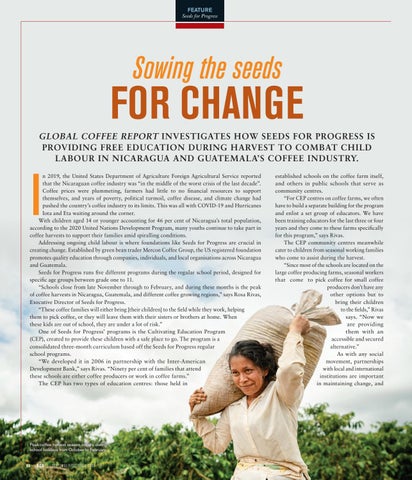FEATURE Seeds for Progress
Sowing the seeds
FOR CHANGE GLOBAL COFFEE REPORT INVESTIGATES HOW SEEDS FOR PROGRESS IS PROVIDING FREE EDUCATION DURING HARVEST TO COMBAT CHILD LABOUR IN NICARAGUA AND GUATEMALA’S COFFEE INDUSTRY.
I
n 2019, the United States Department of Agriculture Foreign Agricultural Service reported that the Nicaraguan coffee industry was “in the middle of the worst crisis of the last decade”. Coffee prices were plummeting, farmers had little to no financial resources to support themselves, and years of poverty, political turmoil, coffee disease, and climate change had pushed the country’s coffee industry to its limits. This was all with COVID-19 and Hurricanes Iota and Eta waiting around the corner. With children aged 14 or younger accounting for 46 per cent of Nicaragua’s total population, according to the 2020 United Nations Development Program, many youths continue to take part in coffee harvests to support their families amid spiralling conditions. Addressing ongoing child labour is where foundations like Seeds for Progress are crucial in creating change. Established by green bean trader Mercon Coffee Group, the US registered foundation promotes quality education through companies, individuals, and local organisations across Nicaragua and Guatemala. Seeds for Progress runs five different programs during the regular school period, designed for specific age groups between grade one to 11. “Schools close from late November through to February, and during these months is the peak of coffee harvests in Nicaragua, Guatemala, and different coffee growing regions,” says Rosa Rivas, Executive Director of Seeds for Progress. “These coffee families will either bring [their children] to the field while they work, helping them to pick coffee, or they will leave them with their sisters or brothers at home. When these kids are out of school, they are under a lot of risk.” One of Seeds for Progress’ programs is the Cultivating Education Program (CEP), created to provide these children with a safe place to go. The program is a consolidated three-month curriculum based off the Seeds for Progress regular school programs. “We developed it in 2006 in partnership with the Inter-American Development Bank,” says Rivas. “Ninety per cent of families that attend these schools are either coffee producers or work in coffee farms.” The CEP has two types of education centres: those held in
Peak coffee harvest season occurs during school holidays from October to February.
52
G C R | S E P T E M B E R / O C T O B E R 2021
established schools on the coffee farm itself, and others in public schools that serve as community centres. “For CEP centres on coffee farms, we often have to build a separate building for the program and enlist a set group of educators. We have been training educators for the last three or four years and they come to these farms specifically for this program,” says Rivas. The CEP community centres meanwhile cater to children from seasonal working families who come to assist during the harvest. “Since most of the schools are located on the large coffee producing farms, seasonal workers that come to pick coffee for small coffee producers don’t have any other options but to bring their children to the fields,” Rivas says. “Now we are providing them with an accessible and secured alternative.” As with any social movement, partnerships with local and international institutions are important in maintaining change, and
